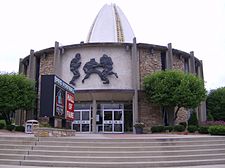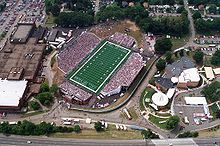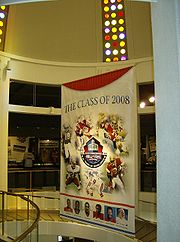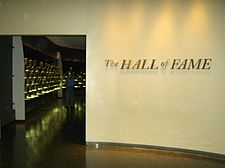- Pro Football Hall of Fame
-
Pro Football Hall of Fame Established 1963 Location Canton, Ohio Type Professional sports hall of fame Website http://www.profootballhof.com/ The Pro Football Hall of Fame is the hall of fame of professional football in the United States with an emphasis on the National Football League (NFL). It opened in Canton, Ohio, on September 7, 1963, with 17 charter inductees.[1] Through 2010, all but one of the player inductees played some part of their pro career in the NFL (the lone exception is Buffalo Bills guard Billy Shaw, who played his entire career in the American Football League (AFL) prior to the 1970 AFL-NFL merger). The Chicago Bears have the most Hall of Famers in the league at 27.[2][3] To date, no player who served exclusively as a punter has been inducted into the Pro Football Hall of Fame, although multiple players enshrined have served their teams in that capacity, most notably Sammy Baugh. Baugh, who played for the Washington Redskins from 1937-1952, had a career punting average of 45.1, which still ranks 6th all-time. However, Baugh is enshrined more for his work as a quarterback and defensive back.
Contents
History
Canton, Ohio was selected as the location for the Hall of Fame for three reasons:[1] First, the NFL, then known as the American Professional Football Association, was founded in Canton in 1920. Second, the now-defunct Canton Bulldogs were a successful NFL team based in Canton during the first few years of the league. And finally, the community of Canton successfully lobbied the NFL to have the Hall built in their city. Groundbreaking for the building was held on August 11, 1962. The original building contained just two rooms, and 19,000 square feet (1,800 m2) of interior space. The Hall opened in 1963 and had 17 inductees.
In April 1970, groundbreaking occurred for the first of many expansions. This first expansion cost $620,000, and was completed in May 1971. The size was increased to 34,000 square feet (3,200 m2) by adding another room. The pro shop opened with this expansion. This was also an important milestone for the Pro Football Hall of Fame, as yearly attendance passed the 200,000 mark for the first time, at least in some part due to the increase in popularity of Pro Football caused by the advent of the American Football League and its success in the final two AFL-NFL World Championship games.
In November 1977, work began on another expansion project, costing US$1,200,000. It was completed in November 1978, enlarging the gift shop and research library, while doubling the size of the theater. The total size of the hall was now 50,500 square feet (4,690 m2), more than 2.5 times the original size.
The building remained largely unchanged until July 1993. The Hall then announced yet another expansion, costing US$9,200,000, and adding a fifth room. This expansion was completed in October 1995. The building's size was increased to 82,307 square feet (7,647 m2). The most notable addition was the GameDay Stadium, which shows an NFL Films production on a 20-foot (6.1 m) by 42-foot (13 m) Cinemascope screen.[4]
Inductees
Main article: List of Pro Football Hall of Fame inducteesSelection process
Board of Selectors
Enshrinees are selected by a 44-person committee, largely made up of sportswriters, officially known as the Board of Selectors.[5]
Usually, the representative is a beat writer for the major newspaper in that city, although this is not always the case; for instance, the Atlanta Falcons are represented by ESPN.com senior writer Len Pasquarelli (who lives in Atlanta and formerly wrote for the Atlanta Journal-Constitution), and the Jacksonville Jaguars are represented by WJXT sports director Sam Kouvaris.
There are also eleven at-large delegates (usually cities that lose NFL teams keep representation on the board; Los Angeles is the only current city to have lost an NFL team and not been granted an expansion team), and one representative from the Pro Football Writers Association. Except for the PFWA representative, who is appointed to a two-year term, all other appointments are open-ended and terminated only by death, retirement, or resignation.
Voting procedure
To be eligible for the nominating process, a player or coach must have been retired at least five years. Any other contributor such as a team owner or executive can be voted in at any time.[6] Unlike the Baseball Hall of Fame, which explicitly waives its five-year waiting period for players who die during that time or while active,[7] the Pro Football Hall of Fame has no provision to waive its waiting period.
Fans may nominate any player, coach or contributor by simply writing to the Pro Football Hall of Fame via letter or email. The Selection Committee is then polled three times by mail to eventually narrow the list to 25 semifinalists: once in March, one in September, and one in October. In November, the committee then selects 15 finalists by mail balloting.
Nine members of the Selection Committee also serve as a subcommittee known as the Seniors Committee to screen candidates who finished their careers 25 or more years prior.[6] The Seniors Committee then adds two finalists from prior to the modern era, making a final ballot of 17.
The Selection Committee then meets the day before each Super Bowl game to elect a new class. To be elected, a finalist must receive at least 80 percent support from the Board, with at least four, but no more than seven, candidates being elected annually. If less than four candidates get 80 percent of the vote, then the top four vote-getters will get in that year. If more than seven get 80 percent, then only the top seven vote-getters will be inducted.
All but one of the people enshrined in the Pro Football Hall of Fame played a large portion of their careers in the National Football League (Billy Shaw, who played his entire career in the American Football League, is the lone exception). Though several Hall of Famers have had AFL, Canadian Football League, World Football League and United States Football League experience, and there is a division of the Hall devoted to alternative leagues such as this, to this point no players have made the Hall without having made significant contributions to either the NFL, AFL or All-America Football Conference. For CFL stars, there is a parallel Canadian Football Hall of Fame; only one player (Warren Moon) and one coach (Bud Grant) are in both halls.
Induction ceremony
The induction ceremony is usually held the first full weekend in August. A community festival is held throughout the week in Canton leading up to the induction ceremonies. Also, the Pro Football Hall of Fame Game, an annual NFL pre-season exhibition game, is held the day after the induction ceremony and officially kicks off the NFL Preseason.
Enshrinees do not go into the Pro Football Hall of Fame as a member of a certain team. Rather, all of an inductee's affiliations are listed equally.[6] While the Baseball Hall of Fame plaques generally depict each of their inductees wearing a particular club's cap (with a few exceptions, such as Catfish Hunter), the bust sculptures of each Pro Football Hall of Fame inductee make no reference to any specific team. In addition to the bust that goes on permanent display at the Hall of Fame, inductees receive a distinctive golden jacket and previous inductees nearly always wear theirs when participating at new inductee ceremonies.
Previous induction ceremonies were held during the day (Sunday from 1999–2005, Saturday in 2006), situated on the steps of the Hall of Fame building. Starting in 2002, the ceremony was moved to Fawcett Stadium, and, beginning in 2007, held Saturday night.[8]
Pro Football Hall of Fame Game
Main article: Pro Football Hall of Fame GameSee also
- Touchdown Club Charities Hall of Fame
- Canadian Football Hall of Fame
- American football
- National Football League
- American Football League
- Canadian Football League
- List of American football players
- Dick McCann Memorial Award - sometimes referred to as the "writer's wing" of the Pro Football Hall of Fame[9]
References
- ^ a b "HOF opened on Sept. 7, 1963". Pro Football Hall of Fame. http://www.profootballhof.com/hall/release.jsp?release_id=932. Retrieved 2007-01-29.
- ^ Pro Football Hall of Fame team history:Chicago Bears
- ^ Green Bay Packers history:Hall of Famers
- ^ The Pro Football Hall of Fame:Then and Now
- ^ "Pro Football Hall of Fame Selection Process". Pro Football Hall of Fame. Archived from the original on 2007-10-12. http://web.archive.org/web/20071012234922/http://www.profootballhof.com/hof/selectionprocess.html. Retrieved 2007-10-31.
- ^ a b c "Pro Football Hall of Fame Selection Process FAQ". Pro Football Hall of Fame. http://www.profootballhof.com/hof/SelectionProcessFAQ.jsp. Retrieved 2007-01-29.
- ^ "Rules for Election: BBWAA". National Baseball Hall of Fame and Museum. http://baseballhall.org/hall-famers/rules-election/bbwaa. Retrieved January 8, 2011. "In case of the death of an active player or a player who has been retired for less than five (5) full years, a candidate who is otherwise eligible shall be eligible in the next regular election held at least six (6) months after the date of death or after the end of the five (5) year period, whichever occurs first. (Rule 3-D)"
- ^ Enshrinement:Class of 2007 Presenters
- ^ "John Clayton bio". ESPN.com. http://www.espnmediazone.com/bios/Talent/Clayton_John.htm. Retrieved 25 March 2010.[dead link]
External links
Categories:- Pro Football Hall of Fame inductees
- American football trophies and awards
- History of American football
- American football museums and halls of fame
- Halls of fame in Ohio
- National halls of fame in the United States
- Sports museums in Ohio
- Museums in Stark County, Ohio
- Canton, Ohio
- Awards established in 1963
Wikimedia Foundation. 2010.




